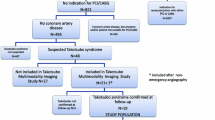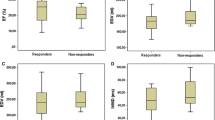Abstract
β-Methyl-p-(123I)-iodophenyl pentadecanoic acid (BMIPP) is one of the branched-chain free fatty acids, which has suitable characteristics for myocardial SPECT because of higher uptake and longer retention in the myocardium. Recent advances of BMIPP myocardial SPECT for evaluating cardiomyopathy were reviewed. BMIPP defects were observed in 80% patients with hypertrophic cardiomyopathy (HCM). Moreover, BMIPP uptake was reduced at sites that corresponded with hypertrophic areas, where thallium uptake was increased. The correlations between severity score and septal wall thickness and LV function were better with BMIPP SPECT, suggesting that BMIPP is more suitable for the assessment of myocardial integrity in HCM. The dissociation between BMIPP and thallium defects was not observed frequently in dilated cardiomyopathy (DCM). We carried out BMIPP myocardial SPECT to evaluate the therapeutic effects of co-enzyme Q10 on DCM patients. Hearts to the mediastinum ratio and BMIPP defect scores were significantly decreased after co-enzyme Q10 treatment. BMIPP myocardial SPECT was confirmed to be sensitive in evaluating the therapeutic effect for the perspective of metabolic SPECT imaging. Recently, a lack of myocardial uptake of BMIPP has been found in a small subset of patients (0.3%–1.2%). Cardiac radionuclide imaging using BMIPP and 18F-FDG were performed on patients with type I CD36 deficiency. The percent dose uptake of 18F-FDG was significantly higher than in normal controls. CD functions as a major myocardial long-chain fatty acid transporter and its absence may lead to a compensatory up-regulation of myocardial glucose uptake. An increased frequency of CD36 deficiency was demonstrated in cardiomyopathy. Therefore, fatty acid transport proteins and their related gene defects in relation to BMIPP uptake may become an important issue in the future.
Similar content being viewed by others
References
Knapp FF, Kropp J. Iodine-123-labelled fatty acids for myocardial single photon emission tomography: Current status and future prospective. Eur J Nucl Med 1995; 22: 361-381
Yamamichi Y, Kusuoka H, Morishita K, et al. Metabolism of Iodine-123-BMIPP in perfused rat heart. J Nucl Med 1995; 36: 1043-1050
Morishita S, Kusuoka H, Yamamichi Y, et al. Kinetics of radioiodinated species in subcellular fraction from rat hearts following administration of Iodine-123-labelled 15-(p-iodophenyl)-3-(R,S)-methylpentadecanoic acid. Eur J Nucl Med 1996; 23: 383-389
Nishimura T, Uehara T, Shimonagata T, Nagata S, Haze K. Clinical results with β-methyl-p-(123I)-iodophenyl pentadecanoic acid single photon emission computed tomography in cardiac disease. J Nucl Cardiol 1994; 1: S65-S71
Ito T, Tanouchi, Kato J, et al. Recovery of impaired left ventricular function in patients with acute myocardial infarction is predicted by the discordance in defect size on I-123-BMIPP and 201TI SPECT imaging. Eur J Nucl Med 1996; 23: 917-923
Franken PR, De Geeter F, Dendale P, Demoor D, Block P, Bossuyt A. Abnormal free fatty acid uptake in subacute myocardial infarction after coronary thrombolysis: correlation with wall motion and inotropic reserve. J Nucl Med 1994; 35: 1758-1765
Maron BJ and Epstein SE. Hypertrophic cardiomyopathy: Recent observations regarding the specificity of three handmarks of the disease: asymmetric hypertrophy, septal disorganization and systolic anterior motion of the anterior mitral anterior leaflet. Am J Cardiol 1980; 45: 141-154
Maron BJ, Bonow RO III, Cannon RO, Leon MB, Epstein SE. Hypertrophic cardiomyopathy: interrelations of clinical manifestations, pathophysiology and therapy. N Engl J Med 1987; 316–780–789, 844-852
Uehara T, Ishida Y, Hayashida K, et al. Myocardial glucose metabolism in patients with hypertrophic cardiomyopathy: assessment by F-18-FDG PET study. Ann Nucl Med 1998; 12: 95-103
Henry WL, Clark CE, Epstein SE. Asymmetric septal hypertrophy: echocardiographic identification of the pathognomonic anatomic abnormality of IHSS. Circulation 1973; 47: 225-233
Shimonagata T, Nishimura T, Uehara T, et al. Discrepancies between myocardial perfusion and free fatty acid metabolism in patients with hypertrophic cardiomyopathy. Nucl Med Comm 1993; 14: 1005-1013
Kurata C, Tawarahara K, Taguchi T, Aoshima S, Kobayashi A, Yamazaki N. Myocardial emission computed tomography with iodine-123-labeled beta-methyl-branched fatty acid in patients with hypertrophic cardiomyopathy. J Nucl Med 1992; 33: 6-13
Nishimura T. Approaches for identity and characterize hypertrophic myocardium. J Nucl Med 1993; 34: 1013-1019
Maron BJ, Wolfson JK, Epstein SE, Roberts WC. Intermural ('small vessel') coronary artery disease in hypertrophic cardiomyopathy. J Am Coll Cardiol 1986; 8: 545-557
Maron BJ, Epstein SE, Roberts WC. Hypertrophic cardiomyopathy and transmural myocardial infarction without significant atherosclerosis of the extramural coronary arteries. Am J Cardiol 1979; 43: 1086-1102
Nishimura T, Nagata S, Uehara T, et al. Prognosis of hypertrophic cardiomyopathy: assessment by 123I-BMIPP myocardial single photon emission computed tomography. Ann Nucl Med 1996; 7: 71-78
Report of the WHO/ISFC task force in the definition and classification of cardiomyopathes. Circulation 1996; 93: 841-842
Johnson RA, Palacious I. Dilated cardiomyopathy of the adult. N Engl J Med 1982; 307: 1051-1058
Dunn RF, Uren RP, Sadik N, et al. Comparison of thallium-201 scanning in idiopathic dilated cardiomyopathy and severe coronary artery disease. Circulation 1982; 66: 804-810
Hirose Y, Ishida Y, Hayashida K, et al. Usefulness of 123I-BMIPP scanning for distinction of ischemic from non ischemic dilated cardiomyopathy. Jpn J Nucl Med 1995; 33: 19-25
Hatefi Y, Haavik AG, Griffiths DE. Reconstitution of the electron transport. Biochem Biophys Res Commu 1961; 4: 447-453
Folkers K, Littarru GP, Runge TM, Havanonda S, Colley D. Evidence for a deficiency of co-enzyme Q10 in human heart disease. Int J vitam Nutr Res 1977; 40: 380-390
Langsjoen P, Vadhanavikit S, Folkers K. Response of patients in classes II and IV of cardiomyopathy to therapy in a blind and crossovers trial with co-enzyme Q10. Proc Natl Acad Sci USA 1985; 82: 4240-4244
Kim Y, Sawada Y, Fujiwara G, Chiba H, Nishimura T. Therapeutic effect of co-enzyme Q10 on idopathic dilated cardiomyopathy: assessment of 123I-BMIPP myocardial single-photon emission tomography. Eur J Nucl Med 1997; 24: 629-634
Kudoh T, Tamaki N, Magata Y, et al. Metabolism substrate with negative myocardial uptake of iodine-123-BMIPP. J Nucl Med 1997; 38: 548-553
Tomiyama Y, Take H, Ikeda H, et al. Identification of the platelet-specific alloantigen, Naka, on platelet membrane glycoprotein IV. Blood 1990; 75: 684-687
Greenwalt DE, Lipsky, RH, Ockenhouse CF, Ikeda H, Tandon NN, Jamieson GA. Membrane glycoprotein CD36: a review of its roles in adherence, signal transduction, and transfusion medicine. Blood 1992; 80: 1105-1115
Abumrad NA, el-Maghrabi MM, Amri EZ, Lopez E, Grimaldi PA. Cloning of a rat adipocyte membrane protein implicated in binding or transport of long-chain fatty acids that is induced during preadipocyte differentiation. Homology with human CD36. J Biol Chem 1993; 268: 17665-17668
Fukuchi K, Nozaki S, Yoshizumi T, et al. Enhanced myocardial glucose uptake in individuals with a deficiency in long-chain fatty acid transport (CD36 deficiency). J Nucl Med 1998; 39 (in press)
Tanaka T, Sohmiya K, Kawamura K. Is CD36 deficiency an etiology of hereditary hypertrophic cardiomyopathy? J Mol Cell Cardiol 1997; 29: 121-127
Author information
Authors and Affiliations
Rights and permissions
About this article
Cite this article
Nishimura, T. β-methyl-p-(123I)-iodophenyl pentadecanoic acid single-photon emission computed tomography in cardiomyopathy. Int J Cardiovasc Imaging 15, 41–48 (1999). https://doi.org/10.1023/A:1006188301035
Issue Date:
DOI: https://doi.org/10.1023/A:1006188301035




